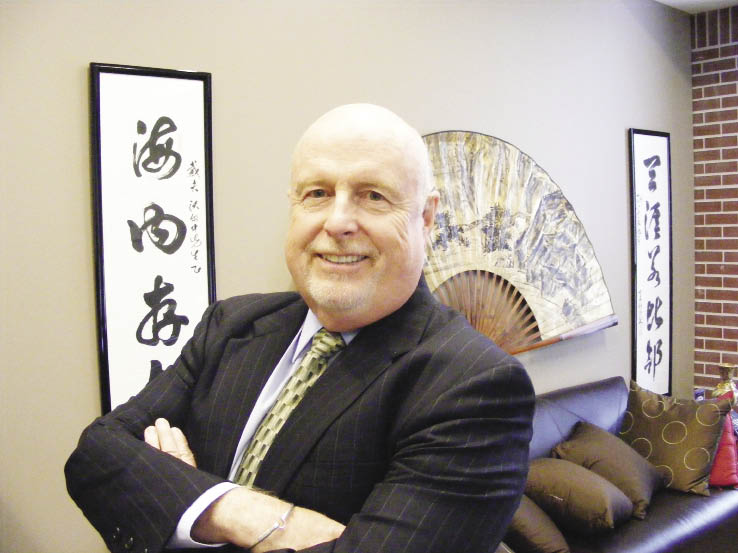David J. Walsh was on his home computer at 4 in the morning last month to connect through Skype with his postgraduate class at a university in Dublin. A student of the trade union movement, Walsh is pursuing a doctoral degree overseas in industrial relations, having earned in recent years a master”™s degree in industrial and labor relations from Cornell University.
In his early 60s, Walsh has done that while running a $170 million-a-year business as president and CEO of Amalgamated Life Insurance Co. and the Amalgamated Family of Companies. In five years, he has successfully grown its diverse businesses and expanded the geographical reach and client base of a 70-year-old-company deeply rooted in serving the financial needs of New York City”™s union workers.
One need not be a scholar in Walsh”™s field to know that union density ”“ the proportion of paid workers that are union members ”“ is, as he noted, “dropping precipitously” both in the U.S. and Europe. At his CEO”™s desk in White Plains, he pulled up federal labor statistics: only 11.3 percent of the U.S. workforce, or 14.4 million workers, in 2012 belonged to unions, down from 11.8 percent in 2011.
That is a radical change from America in 1943, when Sidney Hillman, a self-proclaimed Jewish socialist, former political prisoner in Czarist Russia and confidante of President Franklin D. Roosevelt, formed Amalgamated Life to provide insurance benefits to the workers he led as president of the Amalgamated Clothing Workers of America. In the 1940s, there were 250,000 needlework trades jobs in Greenwich Village alone, Walsh said.

An advocate of “social unionism,” Hillman had already launched cooperative housing and labor banking ventures when he started the life insurance company. In the 1920s he founded Amalgamated Bank to serve clothing union workers.
“We”™re kind of the remnants of that philosophy, which explains why we have all these companies,” Walsh said.
In addition to its life insurance business, the Amalgamated family includes Alicare Inc., a third-party administrator of employee benefit plans; AliGraphics, a printing services company; Alicomp, which provides computer mainframe outsourcing and information technology services; Alicare Medical Management, a health care management company, and Amalgamated Agency, a specialized insurance brokerage.
“When I started, the company had done no advertising at all ”“ ever ”“ for the first 50 years,” Walsh said. “When there were 2 million members of the Amalgamated clothing union, the marketing plan was easy.”
Walsh came to Amalgamated in 2008 from SBLI Mutual Life Insurance Cos., where he was executive vice president and general counsel. A native Iowan who also holds a law degree and a master”™s in business administration, Walsh in his varied career in the public and private sectors did a stint as insurance commissioner and director of international trade for the state of Alaska.
In his first year as CEO, he led Amalgamated”™s search for new headquarters. The move was prompted by New York University”™s purchase of the insurance company”™s Greenwich Village office building and the new landlord”™s plans to use the space for itself.
After scouting Newark and other Manhattan locations, Amalgamated in fall 2008 leased 123,000 square feet of space in the former General Foods headquarters complex at 333 Westchester Ave. Amalgamated occupies two full floors, where it currently employs about 480 workers. The company has about 570 employees nationwide.
Amalgamated”™s headquarters search came in the midst of the recession, when mounting office vacancies and corporate downsizings and closings had landlords lowering rents to attract new tenants. Amalgamated moved into fully furnished turnkey space vacated in 2007 by a major subprime mortgage lender, Argent Mortgage Co.
Compared with the rental rates it would have paid in Manhattan, Amalgamated with the relocation will save $70 million over the 16-year term of its lease, Walsh said. “It was just dumb luck ”“ right place, right time, right circumstances.”
When taking over the company, “It was financially very solid,” Walsh said. “The bones of the company were really, really solid.”
Those bones were nourished by the company”™s legacy of unionism. Through a series of mergers of unions representing New York garment workers and hotel and restaurant employees, Amalgamated”™s client base “remained relatively stable,” Walsh said.
But the company”™s union legacy might not sustain it in an increasingly non-union, global economy. “Eventually that very solid base would have started to erode. ”¦We have had to make this into a real company,” Walsh said.
The company invested $13 million in a new computer and phone system that increased operating efficiency without employee layoffs and raised its call center”™s resolution rate to 98 percent of first calls.
“When I started, we had about 1.4 million phone calls a year. We now have less than a million even though our business has grown by 40 to 50 percent.”
The new CEO brought in a dozen top executives. John Thornton, a former CIGNA executive, tripled Amalgamated”™s sales force in his new post as executive vice president of sales and marketing.
The company has continued its conservative underwriting policy while marketing new insurance products. Its insurance company has expanded to all 50 states and the District of Columbia.
“Our overall growth has been about 8 percent a year for five years,” Walsh said.
While growing the company”™s non-union business, “We expanded our union footprint dramatically. We now do work for almost all of the unions.”
“Right now I would say overall we”™re probably about two-thirds union and one-third non-union” in clientele, Walsh said. “Five and a half years ago, it was 98 percent (union) and 2 percent (non-union). But the two-thirds that we have now is 40 percent bigger” than Amalgamated”™s former union base.



















